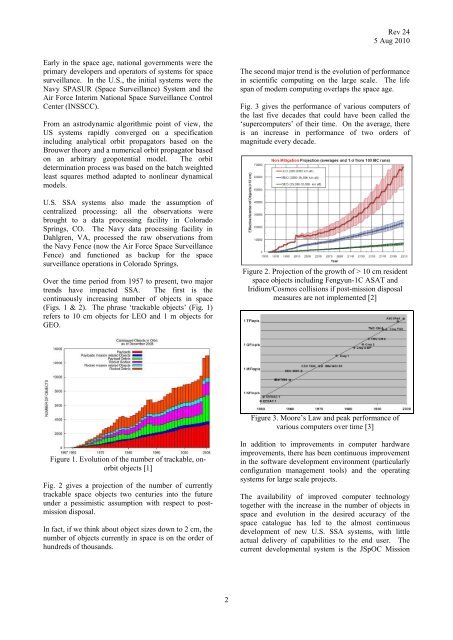open source software suite for space situational ... - Global Error
open source software suite for space situational ... - Global Error
open source software suite for space situational ... - Global Error
You also want an ePaper? Increase the reach of your titles
YUMPU automatically turns print PDFs into web optimized ePapers that Google loves.
Early in the <strong>space</strong> age, national governments were the<br />
primary developers and operators of systems <strong>for</strong> <strong>space</strong><br />
surveillance. In the U.S., the initial systems were the<br />
Navy SPASUR (Space Surveillance) System and the<br />
Air Force Interim National Space Surveillance Control<br />
Center (INSSCC).<br />
From an astrodynamic algorithmic point of view, the<br />
US systems rapidly converged on a specification<br />
including analytical orbit propagators based on the<br />
Brouwer theory and a numerical orbit propagator based<br />
on an arbitrary geopotential model. The orbit<br />
determination process was based on the batch weighted<br />
least squares method adapted to nonlinear dynamical<br />
models.<br />
U.S. SSA systems also made the assumption of<br />
centralized processing: all the observations were<br />
brought to a data processing facility in Colorado<br />
Springs, CO. The Navy data processing facility in<br />
Dahlgren, VA, processed the raw observations from<br />
the Navy Fence (now the Air Force Space Surveillance<br />
Fence) and functioned as backup <strong>for</strong> the <strong>space</strong><br />
surveillance operations in Colorado Springs.<br />
Over the time period from 1957 to present, two major<br />
trends have impacted SSA. The first is the<br />
continuously increasing number of objects in <strong>space</strong><br />
(Figs. 1 & 2). The phrase „trackable objects‟ (Fig. 1)<br />
refers to 10 cm objects <strong>for</strong> LEO and 1 m objects <strong>for</strong><br />
GEO.<br />
Figure 1. Evolution of the number of trackable, onorbit<br />
objects [1]<br />
Fig. 2 gives a projection of the number of currently<br />
trackable <strong>space</strong> objects two centuries into the future<br />
under a pessimistic assumption with respect to postmission<br />
disposal.<br />
In fact, if we think about object sizes down to 2 cm, the<br />
number of objects currently in <strong>space</strong> is on the order of<br />
hundreds of thousands.<br />
2<br />
Rev 24<br />
5 Aug 2010<br />
The second major trend is the evolution of per<strong>for</strong>mance<br />
in scientific computing on the large scale. The life<br />
span of modern computing overlaps the <strong>space</strong> age.<br />
Fig. 3 gives the per<strong>for</strong>mance of various computers of<br />
the last five decades that could have been called the<br />
„supercomputers‟ of their time. On the average, there<br />
is an increase in per<strong>for</strong>mance of two orders of<br />
magnitude every decade.<br />
Figure 2. Projection of the growth of > 10 cm resident<br />
<strong>space</strong> objects including Fengyun-1C ASAT and<br />
Iridium/Cosmos collisions if post-mission disposal<br />
measures are not implemented [2]<br />
Figure 3. Moore‟s Law and peak per<strong>for</strong>mance of<br />
various computers over time [3]<br />
In addition to improvements in computer hardware<br />
improvements, there has been continuous improvement<br />
in the <strong>software</strong> development environment (particularly<br />
configuration management tools) and the operating<br />
systems <strong>for</strong> large scale projects.<br />
The availability of improved computer technology<br />
together with the increase in the number of objects in<br />
<strong>space</strong> and evolution in the desired accuracy of the<br />
<strong>space</strong> catalogue has led to the almost continuous<br />
development of new U.S. SSA systems, with little<br />
actual delivery of capabilities to the end user. The<br />
current developmental system is the JSpOC Mission
















